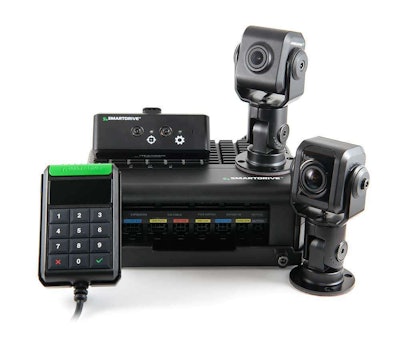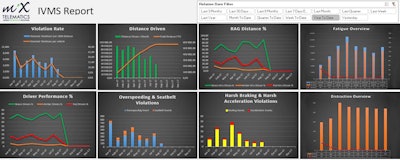 Oakley Transport is installing the SR4 platform from SmartDrive to have a single source of driver safety data. Photo by Steven Diaz, courtesy of SmartDrive.
Oakley Transport is installing the SR4 platform from SmartDrive to have a single source of driver safety data. Photo by Steven Diaz, courtesy of SmartDrive.In October 2017, a top-performing driver for Oakley Transport crossed the centerline of a bridge at approximately 4 a.m.
A windshield-mounted Bendix AutoVue camera system detected the lane departure and instantaneously shared event data with an in-vehicle SmartRecorder device from SmartDrive.
The SmartRecorder captured and transmitted a 20-second video clip of the event to Oakley Transport for review using the SmartIQ web portal from SmartDrive.
“It was a scary moment to watch,” recalls Craig Stevens, Oakley’s vice president of operations and strategic initiatives. He saw the driver shaking himself to stay alert.
After the technology identified the fatigued driver, Oakley Transport’s safety department intervened and provided treatment for what had been a previously undiagnosed sleep apnea.
Fatigue is one of many risky driving behaviors that can be detected using advanced technology. New developments are leading to a convergence of driver-assist technologies and safety data to identify more complex patterns of risk that traditionally have been hidden from view.
Breaking down the technical and competitive barriers of safety technology has made it possible for fleets to more effectively mitigate risks by having more comprehensive and real-time management of vehicle and driver performance.
A single subscription
One of the forces driving technology convergence is the prevalence of advanced driver-assistance systems (ADAS). Eventually, ADAS technology will power autonomous trucks, but in the meantime they are expanding the possibilities to mitigate risks.
 Telematics systems like Navistar’s On Command system will be the linchpin for trucking’s coming technology shift, Navistar CEO Troy Clarke says.
Telematics systems like Navistar’s On Command system will be the linchpin for trucking’s coming technology shift, Navistar CEO Troy Clarke says.Today, fleets may be cobbling together data from multiple ADAS technologies and Internet of Things devices and sensors. For example, a telematics system may report speeding and sudden braking events while a separate video event recorder is used to identify more complex behaviors that triggered the events like fatigue and distraction.
SmartDrive’s latest SR4 platform has expanded possibilities for data integration for reducing costs and giving fleets a “single source of truth” for driver and vehicle performance, says Steve Mitgang, SmartDrive’s chief executive.
Oakley Transport, based in Lake Wales, Fla., is installing the SR4 in its 500-truck fleet.
Oakley Transport orders its Volvo trucks with Bendix AutoVue lane departure warning and Bendix Wingman Fusion systems installed at the factory. The Wingman Fusion system combines adaptive cruise control with active braking and collision mitigation technologies.
The Bendix ADAS systems integrate with the SmartDrive platform to trigger capture of video records based on lane departures and following distances.
Kelly McDowell, Oakley’s director of safety and compliance, says everything managers want to know about driver behaviors and risk is available through the SmartDrive program, which brings data together into “one package to measure safety.”
Vehicle integrators
Truck manufacturers are helping drive the integration of ADAS technology with telematics, video and other safety technologies with connected vehicle platforms.
 The hardware for SmartDrive’s next-generation SR4 platform is able to support up to nine cameras and new machine vision technologies. Photo courtesy of SmartDrive.
The hardware for SmartDrive’s next-generation SR4 platform is able to support up to nine cameras and new machine vision technologies. Photo courtesy of SmartDrive.In 2013, Navistar began using data from telematics systems that its fleet customers were already using to power its remote diagnostics and predictive maintenance service, OnCommand Connection.
In 2017, Navistar launched its own aftermarket telematics hardware and software platform under the same name, OnCommand Connection, with fleet management and ELD applications.
Starting this year, Navistar will be installing OnCommand Connection in all International Trucks at the factory. The technology will serve as an integration hub for ADAS and other connected vehicle technologies that its customers use.
“We have been successful for a long time pulling data from different trucks into one screen. Most fleets don’t own one truck (brand) so we do not have any reason to not continue the same strategy,” says Terry Kline, Navistar’s senior vice president and chief information officer.
By integrating with ADAS systems on a vehicle, Kline can “easily see a future” where OnCommand Connection will alert fleets if a driver has a lane departure event caused by fatigued or distracted driving “so that someone can intervene.”
OnCommand Connection will be able to capture video and data from ADAS and camera systems on vehicles, he adds, and give users to event data and footage through an online portal.
“We view OnCommand Connection as the connection to the vehicle for those data points on safety, lane departure and collision avoidance,” he says.
Bringing it together
With an ever-increasing amount of information that is available on driver safety and performance, it has become difficult for a single vendor to supply everything through a single subscription package.
 PeopleNet’s Safety Analytics dashboard segments drivers into green, yellow and red profiles of risk.
PeopleNet’s Safety Analytics dashboard segments drivers into green, yellow and red profiles of risk.Some vendors have decided to instead focus on their core strengths, which may be to package information from a multitude of sources for fleet managers and drivers to modify behaviors.
Fleet mobility provider PeopleNet, for instance, continues adding more sources of information to its Onboard Event Recorder (OER) application. OER captures data from the vehicle and various ADAS sensors when critical events occur like speeding or sudden deceleration.
PeopleNet’s Video Intelligence product adds video footage to OER events from cameras around the vehicle. The data it captures on driver safety also includes hours-of-service and driving habits and brings everything together into a net score. The scores are managed using an online Safety Analytics dashboard.
Samsara, an enterprise IoT systems company, offers what it describes as “a complete data platform” for transportation operations that combines real-time GPS tracking, wireless sensors, video, and mobile applications.
The platform flags harsh events as they take place for fleet managers to review the footage from those incidents. Samsara doesn’t employ people to review the footage to make risk observations, which helps to keep costs down and gives fleets immediate access to data and video records, says Saleh ElHattab, product manager at Samsara.
 Samsara shows which drivers are safe and who needs more training. Its Safety Inbox surfaces safety events that need to be reviewed.
Samsara shows which drivers are safe and who needs more training. Its Safety Inbox surfaces safety events that need to be reviewed.Samsara is developing new machine vision technologies that will automatically identify risky behaviors, like distraction, that contribute to critical safety events, he says. Fleet safety scores are shown to drivers via the Samsara Driver App.
Mix Telematics is “always looking for different data streams to integrate with,” says Pete Allen, chief client officer. The company offers an integrated camera for its telematics platform and has integrations with Mobileye’s forward collision warning system and Seeing Machines’ fatigue detection system.
Alerts from the Mobileye and Seeing Machines systems can be part of MiX Telematics’ data stream, he says, to identify correlations with driver behaviors caught on camera such as distractions.
“Driver behaviors are precursors to other events happening,” he says.
Teletrac Navman is in the process of deploying a forward-facing camera for its telematics system, Teletrac Navman Director. The system will record video footage when triggered by behaviors such as harsh driving and speeding, says Marco Encinas, marketing and product manager of global platforms.
 MiX Telematics brings together data from internal and third-party sensors to track driver safety performance.
MiX Telematics brings together data from internal and third-party sensors to track driver safety performance.The company is also working on next-generation cameras to incorporate a 360-degree view around the vehicle to detect risky driving behaviors and event records.
As a mobile workforce platform, Verizon Connect has not introduced a camera. Instead, the company integrates with a number of third-party camera systems.
Verizon Connect is focused on creating value for its customers through scorecards rather than adding more IoT devices. The platform comes with a built-in driver scorecard that can utilize event data, such as lane departures, from third-party systems.
Verizon Connect also offers a Coach mobile app that shows drivers how their performance compares to their peers, says Mark Wallin, vice president of product.
Machine learning
As motor carriers continue to adopt ADAS and other forms of safety technology, some companies are using artificial intelligence to detect new patterns of risky behaviors as the volume of data increases.
 Lytx and Mack Trucks recently announced that Mack’s refuse vehicles can be pre-wired at the factory to install the Lytx DriveCam video-based safety program.
Lytx and Mack Trucks recently announced that Mack’s refuse vehicles can be pre-wired at the factory to install the Lytx DriveCam video-based safety program.SmartDrive is using data it captures from OEM and third-party systems to continuously develop and refine driver-assist sensors and machine learning algorithms that detect risk patterns. The company will soon release sensors that can alert drivers, assess behaviors and trigger the capture of event data and video for lane departures, short following distances, forward collision warnings, posted speed detection, traffic signs and signal violations.
Lytx, whose DriveCam program is used by more 3,000 fleets with 500,000 vehicles, is using artificial intelligence to mine its large database and develop new machine vision technologies that will help its customers better understand and predict risk in driving and non-driving events.
Lytx is adding approximately 1 billion of driving miles to its database every two weeks. The scale of data makes it possible to automatically recognize more patterns in unique data sets, says Brandon Nixon, chief executive officer.
“As long as you have unique data sets, you can train (machine vision) to recognize almost anything,” he says.











